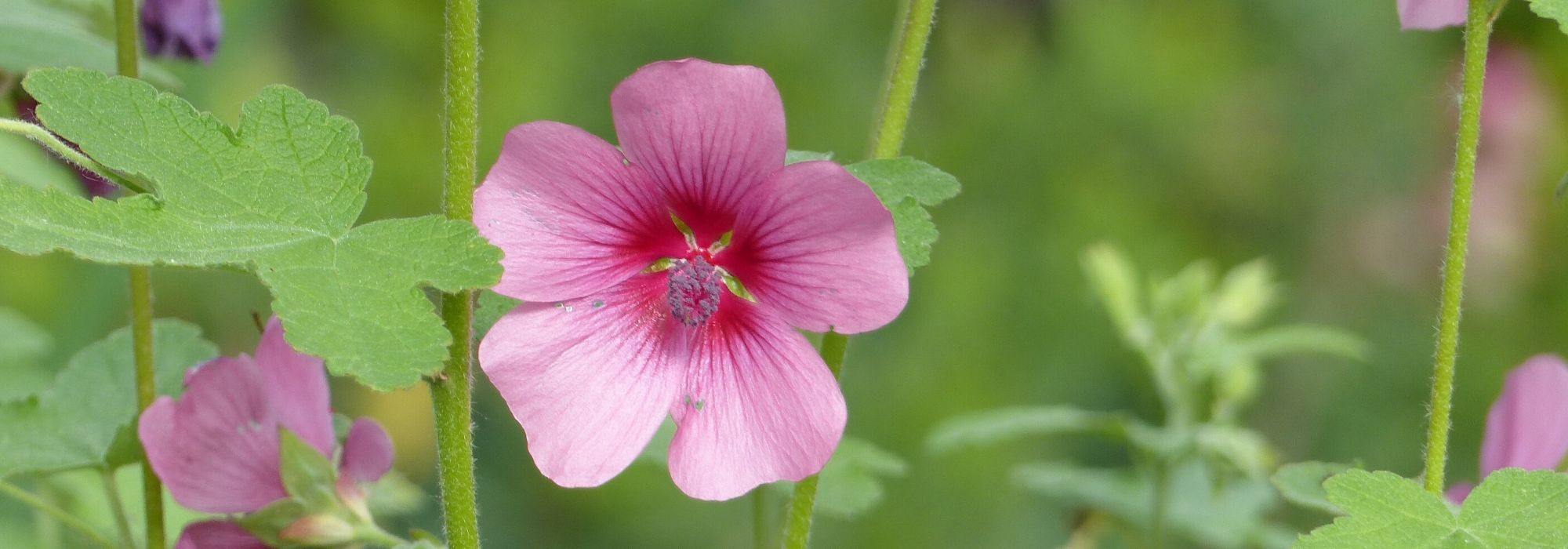
Anisodontea, Cape mallow: planting, care, pruning
Contents
Anisodontea in a nutshell
- Anisodontea is a small bush with an exceptionally floriferous and colourful elegant silhouette.
- Throughout summer and until the first frosts, the bush is covered in small pink hibiscus flowers.
- Hardy down to -8 to -10°C in very well-drained soil, it is best suited to mild climates and seaside or Mediterranean gardens.
- In cooler climates, it can be grown in a large pot on the terrace to winter indoors.
- Charming as a standalone specimen, it also allows for the creation of lovely flowering hedges and romantic borders.
A word from our expert
Anisodontea is a bush mallow that quickly forms a charming flowering bush, rarely exceeding 2 m in height. The species Anisodontea capensis, commonly known as Cape Mallow, is the most common, as is its variety the Anisodontea capensis ‘El Rayo’, which is exceptionally floriferous and bright. This bush can be trained upright or as a standard.
With its numerous flowers resembling those of Hibiscus, blooming all summer and until the first frosts, in all shades of pink and mauve, it easily pairs with all sorts of perennials and bushes in cottage gardens, seaside gardens, small hedges, and romantic borders.
It is not very hardy (down to -8°/ -10°C) and, outside of our mild climates, it makes an excellent terrace or balcony plant that should be grown in a pot and sheltered from severe frosts in winter. It indeed grows very well in pots, allowing enjoyment even in regions with particularly cold winters.
This semi-perennial, semi-bush plant is low-maintenance, loves full sun, and adapts to any soil, even ordinary, dry, and well-drained.
Indefatigable, it shines as a small specimen plant but can also be integrated into a flowering hedge or a summer border.
Discover this unique little bush related to hibiscus that is just as comfortable in the ground as in a large pot on the terrace!
Description and Botany
Botanical data
- Latin name Anisodontea capensis
- Family Malvaceae
- Common name Anisodontea, Cape Mallow
- Flowering April to November
- Height 1 to 2 m
- Sun exposure Sun
- Soil type Well-drained
- Hardiness -10°C
Anisodontea is a bush plant belonging to the Malvaceae family, just like bush lavateras, hibiscus, and mallows, with which it can be confused. It is native to South Africa, specifically the dry rocky areas of the Cape Province.
The genus Anisodontea comprises around twenty species of bushy perennials, the most well-known being Anisodontea capensis (syn. Malvastrum capense), commonly known as “Cape Mallow”. It has given rise to ‘El Rayo’, an exceptionally floriferous and colourful variety, as well as a few hybrids. There is also Anisodontea scabrosa, with pale pink, round flowers, and Anisodontea malvatroides, the largest of the three species, whose flowers resemble those of the althea.
Partly perennial, partly bush, this plant develops from a woody stump. Its growth is rapid. Anisodontea forms a bushy clump of upright stems that quickly reaches heights of 1 to 1.80 metres, with a spread of 0.80 m. This small bush has a somewhat loose but well-branched habit.
The long, thin stems have a reddish-brown bark when juvenile and are slightly hairy, bearing a rather sparse foliage. It consists of alternate leaves, deeply lobed into 3 or 5 dentate lobes, and wrinkled. They are stipulate: their petiole is surrounded by two characteristic pointed bracts. Slightly downy, they can measure from 2 to 10 cm wide and are a remarkable dark green, sometimes grey-green. They will persist through winter in mild climates and coastal areas. The leaves arranged on the upper part of the stems are smaller than those at the base. The foliage of the Cape Mallow is aromatic when crushed.
From this beautifully cut vegetation emerge flowers reminiscent of the delicacy of those of lavateras, hibiscus, and mallows. From April to October, or even all year round in mild climates, they appear solitary or in pairs at the axil of the leaves. They are continuously renewed in successive waves.
The flowering takes the form of small cup-shaped flowers 2 to 4 cm in diameter, composed of five well-separated petals with two lobes. They are held by a fine peduncle and encased in a calyx with 5 sepals. In some cultivars, the petals are deeply notched in a heart shape. The centre of the corolla contains a purple pistil and numerous prominent stamens with bluish-grey anthers grouped in a tight column about 1 cm long.
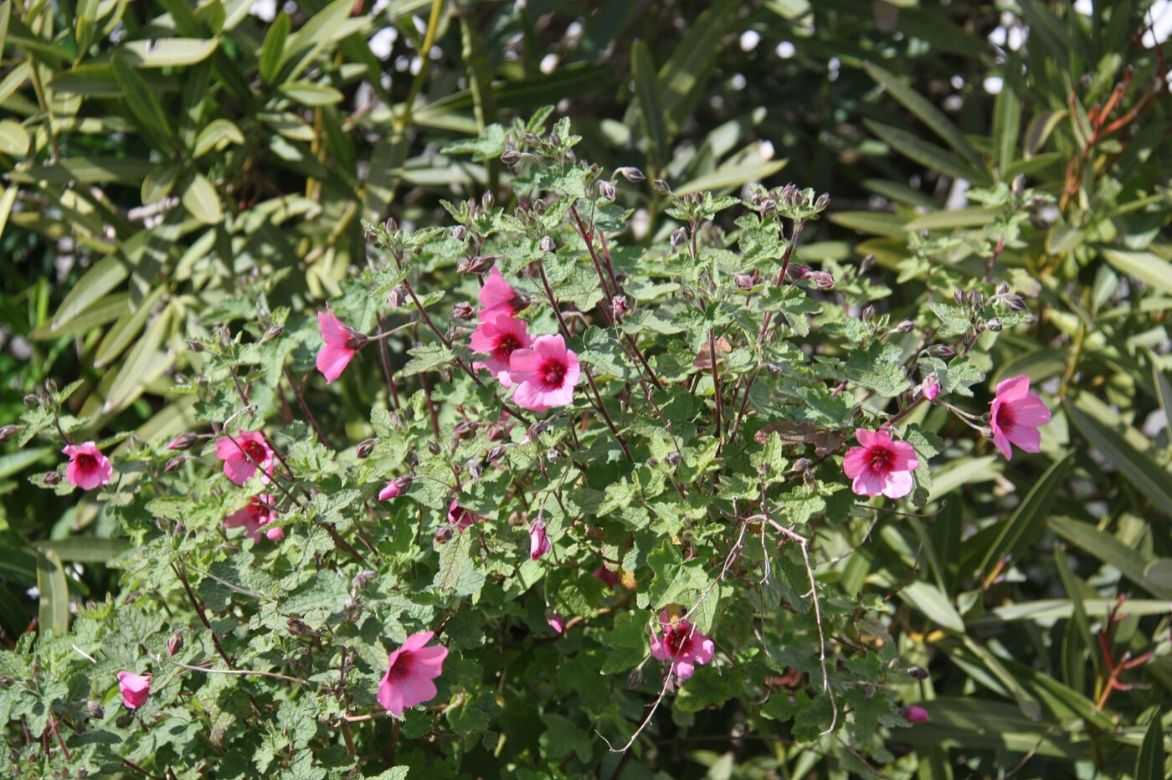 The Anisodontea ‘El Rayo’, a very floriferous variety!
The Anisodontea ‘El Rayo’, a very floriferous variety!
They explore all shades of pink, from very pale pink to soft pink, including magenta, and are more rarely white. Their petals are subtly veined darker or marked with white and a deeper shade at the base.
Non-fragrant and ephemeral, they more than compensate with their remarkable floriferousness, renewing tirelessly until the first frosts.
This melliferous flowering attracts pollinating insects all summer long. Once fertilised, each flower produces seeds that are fused and arranged in a circle.
This small bush is not very hardy (down to -8°/ -10°C in very well-drained soil) and can be grown in open ground in dry, mild climates. Outside of our mild climates, it is an excellent plant for terraces or balconies, grown in pots to protect it from severe frosts in winter.
Main varieties
Our Favourite
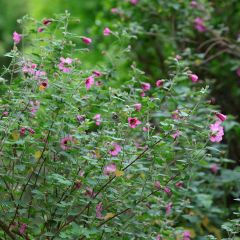
Anisodontea capensis El Rayo
- Flowering time July to November
- Height at maturity 1,20 m
Most Popular
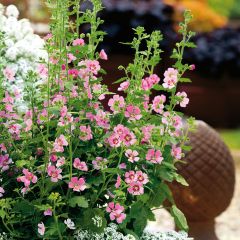
Anisodontea Lady in Pink - Cape Mallow
- Flowering time June to November
- Height at maturity 1 m
Discover other Anisodontea
View all →Available in 2 sizes
Available in 1 sizes
Available in 1 sizes
Available in 1 sizes
Available in 1 sizes
Planting
Where to plant it?
Anisodontea is easily grown in open ground in mild regions where temperatures rarely drop below -5°C. In well-drained soil, Anisodontea capensis can withstand temperatures down to -8°/-10°C. It is well-suited for seaside or Mediterranean gardens. Once established, it is quite drought-resistant. Anisodontea malvatroides will tolerate colder temperatures (-10°C) better than A. capensis and its hybrids.
In our less temperate regions, grow it in a pot so you can move it indoors during winter to a cool, well-lit location. It makes a lovely terrace and patio plant in colder climates. Growing Anisodontea indoors is possible, provided you ensure the plant has a period of dormancy in winter, keeping it cool and well-lit, and reducing watering.
In open ground, in a mild climate, plant Anisodontea in full sun, in well-drained, light, deep, humus-bearing soil, even calcareous. Native to the arid regions of the Cape, it prefers soil that is even slightly dry, as it will thrive longer in such conditions, being sensitive to waterlogged, clayey, and suffocating soils. It will not survive if winter moisture is too high. In clay soil, plant the bush on a slight mound to allow better drainage.
In exposed areas, provide it with a sunny spot that is well-sheltered from strong winds and severe winter cold.
Ensure it has a clear space as it will quickly occupy 1m².
In regions with mild winters, it will quickly make a striking impact in a small informal hedge or in a shrub border. Its moderate growth allows it to be planted alone or in a pot on a small terrace. It is essential in cottage gardens and naturalistic gardens, adding a touch of tenderness to romantic scenes.
When to plant Anisodontea?
Planting Anisodontea should be done after the frosts, when temperatures rise to around 10°C, from March to May in the north of the Loire and in September-October in the “orange zone”.
How to plant it?
In open ground
Space the plants 1m apart in all directions. In heavy, clayey soils, add river sand or gravel and potting soil.
- Prepare the soil well
- Hydrate the root ball by soaking it in a basin of water
- Dig a hole 2 to 3 times the size of the root ball
- Spread gravel at the bottom of the hole
- Plant the bush at collar level in enriched garden soil with compost and potting soil
- Fill the hole
- Lightly compact with your foot
- Mulch to keep the soil cool during establishment
- Water
In a pot
The substrate must be very well-draining with no standing water. Choose a terracotta container of at least 50 cm in diameter.
- Spread a good layer of drainage (gravel or clay balls)
- Plant in a mix of loamy soil, potting soil for Mediterranean plants, and coarse sand
- Water regularly and abundantly, allowing the substrate to dry slightly between waterings
- Bring the pot indoors to protect it from frost in cold regions and reduce watering
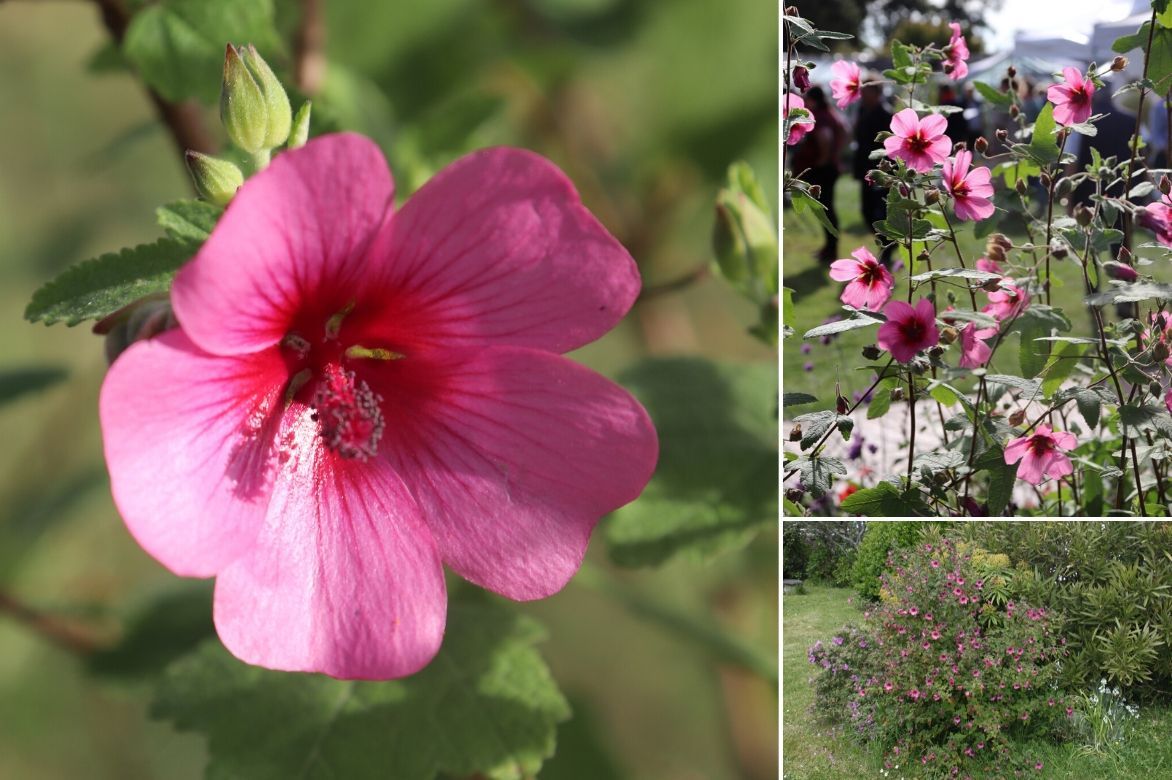 The Anisodontea ‘El Rayo’ forms a lovely bush covered in small pink flowers veined with red and a purple centre.
The Anisodontea ‘El Rayo’ forms a lovely bush covered in small pink flowers veined with red and a purple centre.
Maintenance, pruning and care
Anisodontea is easy to care for when well established in perfectly drained soil, where it offers better hardiness and greater resistance to the passage of time.
It requires regular watering but without excess during the first two years after planting; afterwards, it will withstand drought well: its flowering will last longer if the soil remains moist. There is no need to water during winter, as it is content with rainwater.
In spring, apply a few handfuls of well-rotted compost by scratching it into the base of the plant.
In summer, mulch around the base to retain moisture and reduce the need for watering.
Cut off faded flowers to encourage further blooming. Regularly pinch the stems to promote branching.
In winter, mulch the stump with a thick layer of fallen leaves or dry ferns to insulate its roots from the cold as much as possible. As a precaution, wrap the aerial parts with horticultural fleece.
At the end of winter, use a pruning shear to shorten the branches by about one-third of their length to maintain a bushy plant and a dense silhouette. This pruning accelerates their growth and ensures spectacular flowering. It can also be trained as a standard (retain the most central and sturdy branch, remove all shoots along three-quarters of its length, and allow only the upper branches to develop).
In pots, it requires more frequent watering in summer; water once a week while allowing the substrate to dry out between waterings. Also, add a flowering plant fertiliser to the watering can twice a month during the flowering period.
In regions with mild winters, you can leave pots outside with good protection as a precaution, as potted plants are more sensitive to cold. Wrap the pot with cardboard and/or hessian and protect the top with horticultural fleece. Elsewhere, bring your pots indoors in autumn to a cool (12-14 °C) and bright location, keeping them frost-free, and reduce watering to once a month. Top up annually and repot every three years.
→ Learn more about pruning Anisodontea in our tutorial!
Diseases and potential pests
Planted in well-draining soil and kept warm, Anisodontea shows good resistance to diseases, truly fearing only two things: excess moisture at the roots and negative temperatures. When grown in a conservatory or greenhouse, the bush can be affected by red spider mites and whiteflies, small white flies. In the first case, mist the foliage to eliminate them; in the second, make sprays with a mixture of water and black soap.
Multiplication: cutting, sowing
The propagation of Cape mallow is easily done by sowing in spring if you have collected the small seeds from the dried capsules of your plants, or by propagation by cuttings in spring or summer from herbaceous or semi-herbaceous shoots. This is a good way to ensure the longevity of your plants.
How to take a cutting of Anisodontea?
- Take terminal cuttings of 10 cm long from non-flowering stems
- Trim the leaves to two-thirds of their height from the base
- Insert them into a tray filled with a light mix of sand and potting soil, kept very slightly moist
- Cover the cuttings by wrapping the container in a clear plastic bag
- Ventilate after 3-4 weeks
- Transplant into individual pots
- Keep your cuttings protected from the cold (at 10-12 °C)
- Regularly pinch the stems
- Transplant into the ground in spring
→ Learn more in our tutorial How to propagate Anisodontea or Cape mallow?
Sowing
Collect the seeds in autumn, when the capsules begin to open.
- In January-February, sow the seeds in individual pots filled with good seed compost
- Keep warm at 20°C and moist until germination
- Wait a year before permanently planting them in pots or in the ground
Associate
Anisodontea is essential in a dry naturalist garden, in a cottage garden, and of course in a pink garden. It adds density and brightness to romantic borders, free hedges, mixed borders, and rockeries. In regions with very harsh winters, plant it in a pot so you can bring it indoors during winter. It will enhance a terrace or a large balcony.
In our regions that experience mild winters, it will look beautiful in a medium-height free hedge, or in a border where you can pair it with other flowering bushes such as Hibiscus syriacus ‘Pink Chiffon’, lavateras ‘Candy Floss’ and ‘Blushing Bride’, buddleias, or Abelia grandiflora.
Planted at the heart of a romantic pink border, pair it with summer-flowering perennials that also love the sun, such as sedums, gauras, phlox, large asters, yarrow ‘Cerise Queen’, and lavenders. Add some light grasses for a finishing touch!
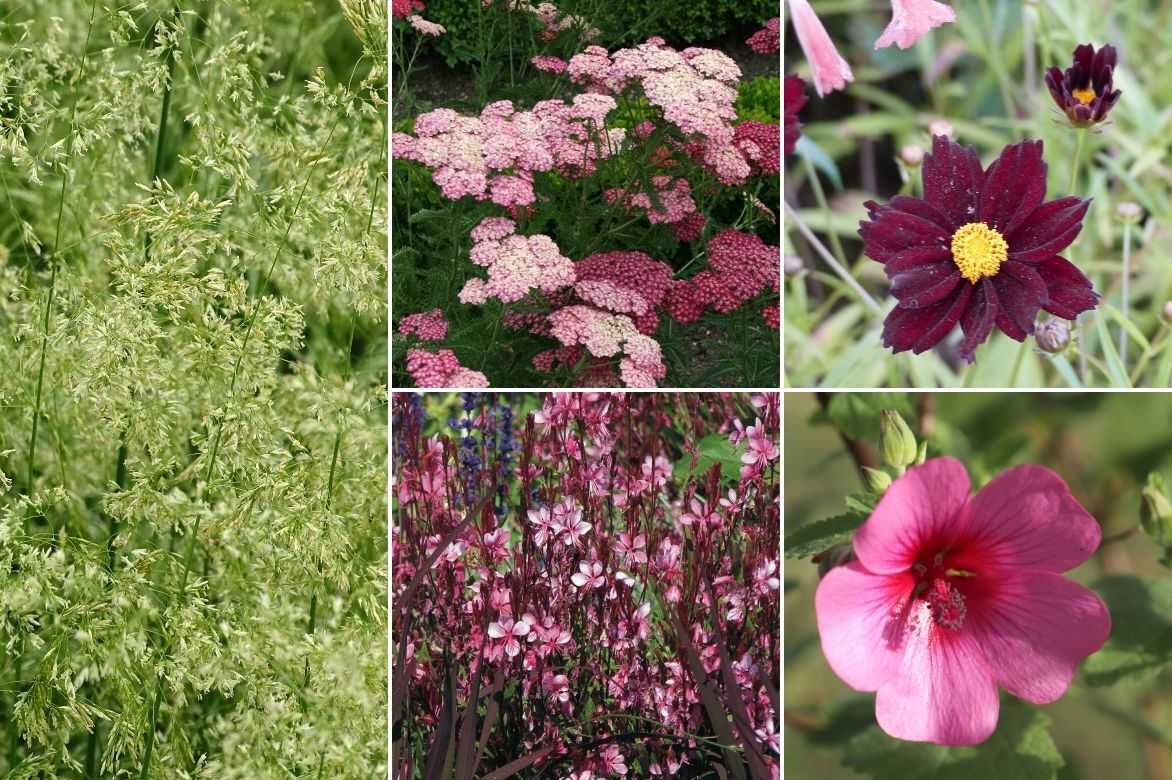
An example of pairing in shades of pink: Achillea ‘Cerise Queen’, Coreopsis ‘Mercury Rising’, Gaura ‘Lilipops Pink’, Anisodontea ‘El Rayo’, and Deschampsia ‘Goldschleier’
Its combination with Sages, or even with its relatives the Hollyhocks and Mallow, is full of romance, creating scenes of great softness in the heart of summer. It is also an excellent partner for old roses in pink or white.
With its pastel-coloured flowers, it is perfect for cool colour combinations with purple foliage (heucheras, Cotinus ‘Royal Purple’, Pittosporum ‘Tom Thumb’, or Nandina domestica), silver or glaucous (perennial wormwoods, poppies).
To extend its flowering until the first frosts, mix it with Japanese anemones, large sedums, and hardy geraniums.
Useful resources
- Find our complete range of anisodontea
- Discover our tips for growing Anisodontea in pots
- Lavateras, hibiscus, hollyhocks… Draw inspiration from the large family of Malvaceae to create a pink inspiration in the garden!
- ‘Anisodontea is easy to pair with many summer-flowering perennials and flowering bushes
- Diseases and pests of Anisodontea
- Anisodontea or Cape Mallow: pairing ideas for different garden styles
- Subscribe!
- Contents
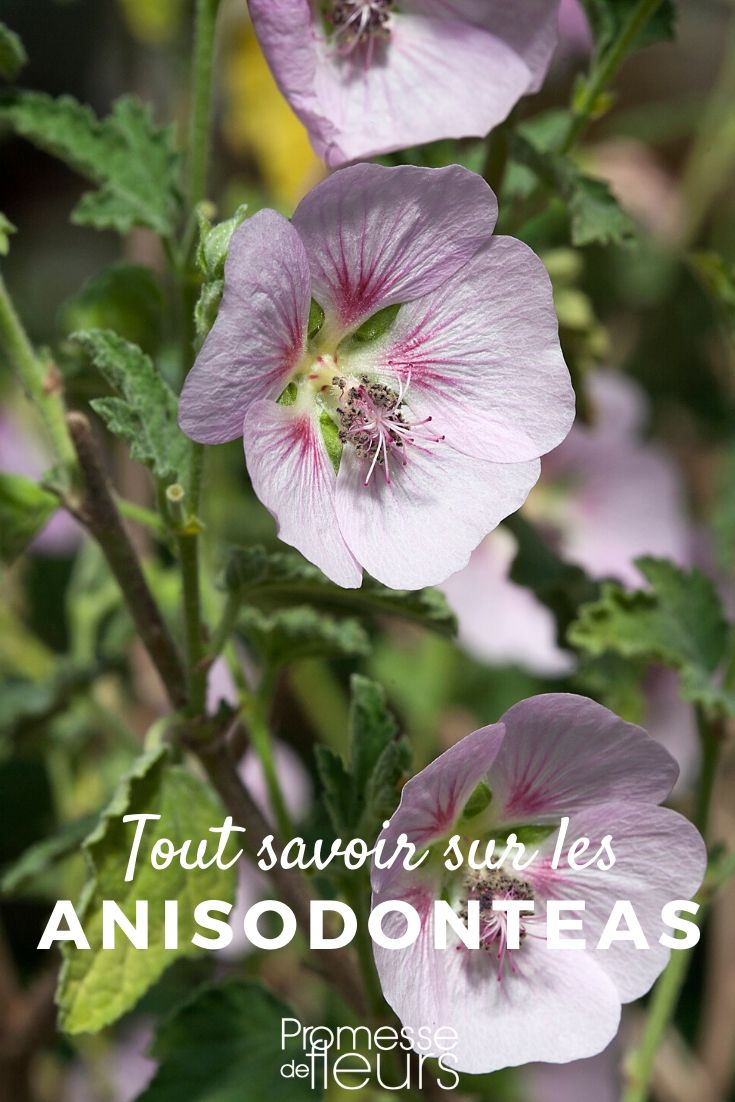
































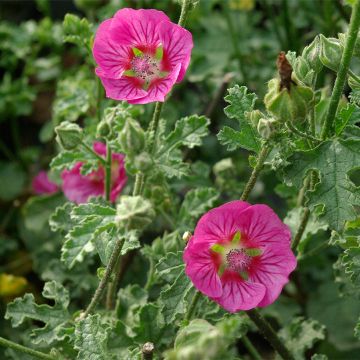

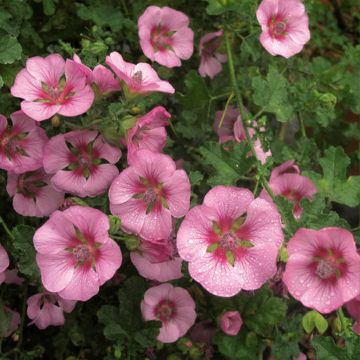
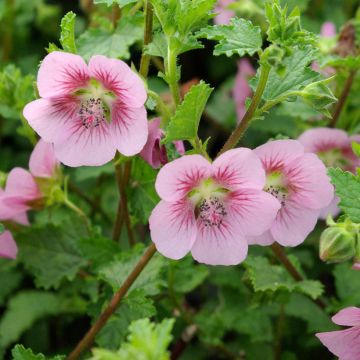
Comments